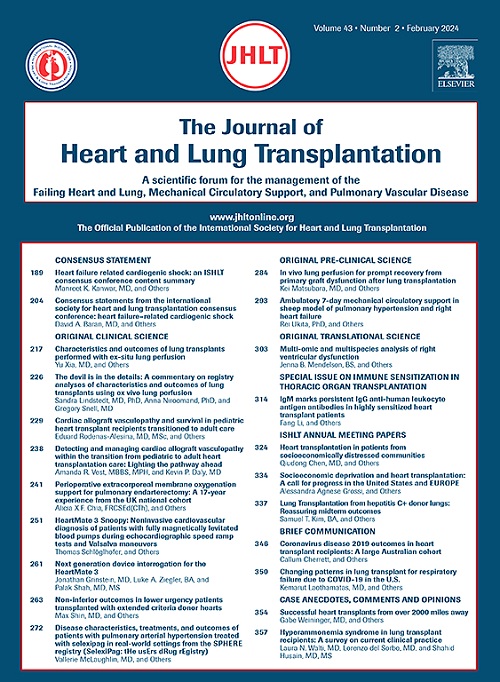Recurrent treatment of refractory acute cellular rejection with alemtuzumab after lung transplantation
IF 6.4
1区 医学
Q1 CARDIAC & CARDIOVASCULAR SYSTEMS
引用次数: 0
Abstract
We present an exceptional case of a lung transplant recipient successfully treated by multiple courses of alemtuzumab for refractory acute cellular rejection (ACR). The patient experienced multiple episodes of ACR following the transplantation procedure. Alemtuzumab was initiated as a third-line rejection treatment and was repeated 6 times. Each treatment course resulted in complete recovery of the pulmonary function and depletion of T- and B-lymphocytes and natural killer cells (NK cells). The onset of rejection was consistently preceded by the recovery of NK cells, while T- and B-lymphocytes remained depleted. This suggests a rejection process mediated by NK cells. This case contributes to recent research findings suggesting that NK cells play a significant role in ACR in lung transplant recipients and stresses the importance to further investigate the role of NK cells in rejection. Furthermore, it demonstrates that ACR following lung transplantation can be repeatedly managed by treatment with alemtuzumab.
用阿来珠单抗治疗肺移植术后复发的难治性急性细胞排斥反应
我们介绍了一例肺移植受者的特殊病例,患者因难治性急性细胞排斥反应接受了多个疗程的阿仑妥珠单抗治疗,并获得成功。患者在移植手术后经历了多次急性细胞排斥反应。阿来珠单抗被作为三线排斥治疗药物,并重复治疗了六次。每个疗程后,患者的肺功能完全恢复,T淋巴细胞、B淋巴细胞和NK细胞消耗殆尽。排异反应的发生始终先于 NK 细胞的恢复,而 T 淋巴细胞和 B 淋巴细胞仍在消耗。这表明排斥反应过程是由 NK 细胞介导的。最近的研究结果表明,NK细胞在肺移植受者的急性细胞排斥反应中起着重要作用,本病例有助于进一步研究NK细胞在排斥反应中的作用。此外,该病例还表明,肺移植术后的急性细胞排斥反应可通过阿利珠单抗治疗反复控制。数据可用性声明:作者确认文章中提供了支持该研究结果的数据。
本文章由计算机程序翻译,如有差异,请以英文原文为准。
求助全文
约1分钟内获得全文
求助全文
来源期刊
CiteScore
10.10
自引率
6.70%
发文量
1667
审稿时长
69 days
期刊介绍:
The Journal of Heart and Lung Transplantation, the official publication of the International Society for Heart and Lung Transplantation, brings readers essential scholarly and timely information in the field of cardio-pulmonary transplantation, mechanical and biological support of the failing heart, advanced lung disease (including pulmonary vascular disease) and cell replacement therapy. Importantly, the journal also serves as a medium of communication of pre-clinical sciences in all these rapidly expanding areas.

 求助内容:
求助内容: 应助结果提醒方式:
应助结果提醒方式:


